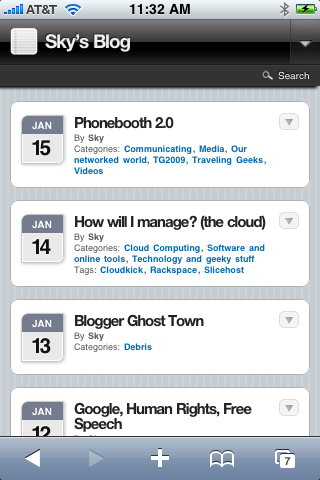 The predominant “web server software” used for WordPress sites are Apache and nginx. [1. tech discussion: Apache launches a new thread (a “program”) in server memory for every incoming page and object requested by your site visitors. This can rapidly clog the server’s memory as the number of requests per second increases. nginx initially launches a number of threads and then dispatches page/object requests to them for service—properly configured it doesn’t bloat up and fill memory.] Generally on smaller servers nginx will be more efficient because it doesn’t gobble memory like Apache does. The question of which web server software to use hinges primarily on the CPU power and memory resources that are required on the server side to make your site run properly. [Read more…]
The predominant “web server software” used for WordPress sites are Apache and nginx. [1. tech discussion: Apache launches a new thread (a “program”) in server memory for every incoming page and object requested by your site visitors. This can rapidly clog the server’s memory as the number of requests per second increases. nginx initially launches a number of threads and then dispatches page/object requests to them for service—properly configured it doesn’t bloat up and fill memory.] Generally on smaller servers nginx will be more efficient because it doesn’t gobble memory like Apache does. The question of which web server software to use hinges primarily on the CPU power and memory resources that are required on the server side to make your site run properly. [Read more…]
WordPress iPhone “Theme” is Fantastic!

 About the WPtouch Mobile Plugin— I ran across this in the news sidebar on a blog I was editing this morning. It’s a WordPress plug-in (yes, it’s not actually a theme even though they refer to it that way sometimes) that converts a regular WP blog so that it reads nicely on a small/narrow screen (like that of an iPhone or iPodTouch). Using javascript (which does work on iPhones, unlike Flash) it lets you see first the titles of articles[1], then you can click a triangle to expand and see the short description, and click a triangle again to read the entire article. I had one problem[2] (so far) but I love what it does.
About the WPtouch Mobile Plugin— I ran across this in the news sidebar on a blog I was editing this morning. It’s a WordPress plug-in (yes, it’s not actually a theme even though they refer to it that way sometimes) that converts a regular WP blog so that it reads nicely on a small/narrow screen (like that of an iPhone or iPodTouch). Using javascript (which does work on iPhones, unlike Flash) it lets you see first the titles of articles[1], then you can click a triangle to expand and see the short description, and click a triangle again to read the entire article. I had one problem[2] (so far) but I love what it does.
[If you’re reading this on an iPhone you’re already seeing how it works, if not you should feel free to pull out whatever your smartphone is and go to my blog home page to see how it works.]
When you visit a blog that has this plug-in enabled, if you’re on an iPhone (or some other smartphones) you’ll see a concise display of the most recent entries in the blog. It includes titles, dates, and categories only. [Illustration left.] My blog theme is white type against a black background, but the plug-in takes just the pertinent information and displays that using a substitute theme that looks fine on the iPhone screen.
Then… [Read more…]
Use OpenID on your WordPress blog!
 I like OpenID[1] although I think it’s more complex than most people can handle — and that’s a big hurdle. OpenID gives visitors to your blog or web site a chance to log in (create an account on your site) using their login information from a participating OpenID web site (like gmail). In other words, they don’t have to create a separate account at your blog – they just reuse their Yahoo (or gmail or other[2]) account. In theory this should make it easier to remember account names and passwords because you just use one account to log in at many sites.Ever since OpenID was announced (2005) I’ve loved the idea. There are OpenID providers, and then there are other sites that allow users to utilize OpenID for the creation of accounts.
I like OpenID[1] although I think it’s more complex than most people can handle — and that’s a big hurdle. OpenID gives visitors to your blog or web site a chance to log in (create an account on your site) using their login information from a participating OpenID web site (like gmail). In other words, they don’t have to create a separate account at your blog – they just reuse their Yahoo (or gmail or other[2]) account. In theory this should make it easier to remember account names and passwords because you just use one account to log in at many sites.Ever since OpenID was announced (2005) I’ve loved the idea. There are OpenID providers, and then there are other sites that allow users to utilize OpenID for the creation of accounts.
How to Embed Flickr Slideshows in WordPress blogs
 The old method for embedding a Flickr slideshow in a WordPress blog no longer works after WP 2.1. Flickr creates really nice Flash-driven slideshows and there’s easy HTML code to embed these shows on regular web pages, but the code doesn’t work on WordPress-driven sites because the (tinyMCE) editor software removes the code. Now there’s a solution. [Read more…]
The old method for embedding a Flickr slideshow in a WordPress blog no longer works after WP 2.1. Flickr creates really nice Flash-driven slideshows and there’s easy HTML code to embed these shows on regular web pages, but the code doesn’t work on WordPress-driven sites because the (tinyMCE) editor software removes the code. Now there’s a solution. [Read more…]